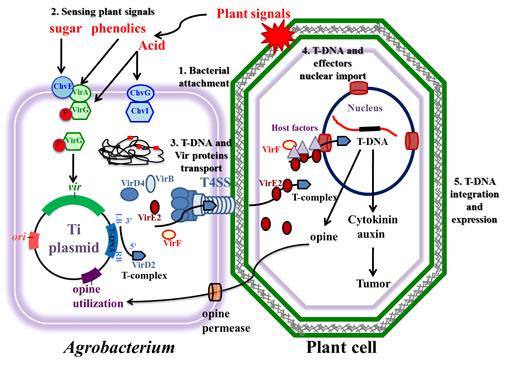Summary
Agrobacterium tumefaciens is a widely used microbial tool in plant molecular biology to transfer DNA into plant cells and produce, for example, stable or transient transformants or induce gene silencing. In our study, we present a simplified version of electrocompetent cell preparation that is not only efficient in terms of time and cost but requires minimal handling of bacterial cells. Liquid cultures are commonly used to prepare competent Agrobacterium cells. To overcome the difficulties of working with liquid cultures, we propose to suspend the bacterial cells directly from the agar plate cultures overnight.
In addition, we optimized several parameters to simplify the procedure and maximize the number of transformants (eg, Agrobacterium strains, number of wash steps, amount of plasmid DNA required, electroporation parameters, type of incubation medium, or incubation time). ). This simple and fast optimized protocol has been shown to be efficient enough to obtain transformed colonies with low amounts (as little as 1 ng) of plasmid DNA. In addition, it also allowed us to introduce ligated plasmids directly into Agrobacterium Electrocompetent Cells by skipping the E. coli transformation step and further accelerating the cloning procedure.
Keywords: Agrobacterium, Electroporation, Plate method, Direct transformation
Materials and methods
Bacterial strains and plasmid
A. tumefaciens strains: MOG301 (Hood et al. 1993), EHA 105 (Hood et al. 1993) and LBA 4404 (Hoekema et al. 1983) were grown on Luria broth solidified with agar (LB) (10 g/L of tryptone, 5 g/L of yeast extract, 5 g/L of NaCl and 15 g/L of agar) supplemented with 50 μg/mL of rifampin (Serva). After electroporation, the bacteria were cultured in liquid SOC medium (glucose 20 mM, tryptone 20 g/L, yeast extract 5 g/L, NaCl 10 mM, MgCl2 2.5 mM and MgSO4 10 mM) or in liquid medium LB. For electroporation experiments, plasmid pTRV2 in pCAMBIA3301 (Arabidopsis Biological Resource Center, STOCK: CD3-1043) was used.

Optimized electrocompetent cell preparation and electroporation protocol
- Freshly cultured cells (1 to 2 days old) of the chosen Agrobacterium strain were spread on LB agar plates (diameter = 90 mm, supplemented with the required antibiotics) and incubated overnight (~16 h) at 27 °C to produce bacterial lawns that completely covered the surface of the plate. If a larger volume of electrocompetent cell suspension was required, cells were harvested from more than one plate.
- Bacterial cells were carefully washed from the plate with 4 ml of ice-cold sterile 10% (v/v) glycerol. The cells that grew on the surface of the plate were scraped with an inoculation loop, avoiding damaging the agar medium, and were suspended in the glycerol solution. The bacterial suspension was then transferred to two 2 ml sterile centrifuge tubes.
- The suspensions in the two tubes were centrifuged at 14,000 rpm (18,000 g) for 1 min at 4 °C; the supernatant was discarded.
- 1 mL of ice-cold sterile 10% (v/v) glycerol was added to each tube containing the bacterial pellet. The tubes were then shaken thoroughly to resuspend the cells and step 3 was repeated one more time.
- After the two centrifugation steps, the supernatant was removed and discarded again, and the bacterial pellets in the two tubes were resuspended in 200–200 μl of ice-cold sterile 10% (v/v) glycerol each and combined. in a tube (yielding 400 µl in total).
- The tube with the Agrobacterium cell suspension was kept on ice until electroporation. (Unused electrocompetent cells can be aliquoted and frozen in liquid nitrogen and stored at -70°C).
- For electroporation, 70–80 μl of the ice-cold suspension of electrocompetent bacterial cells were mixed with 1–3 μl of plasmid DNA (1–100 ng) in a sterile centrifuge tube.
- This mixture was loaded into a chilled electroporation cuvette (gap = 2 mm) and placed in the cuvette holder.
- The electroporator was used with the following parameters: 2.5 kV, 25 μF of capacitance and 400 Ohm of resistance.
- One ml of SOC medium was immediately added to the electroporation cuvette and the resulting bacterial suspension was transferred to a 15 ml centrifuge tube and the tube was incubated at 27 °C for 1 h with rotation. (1 h of incubation is usually sufficient to obtain the desired number of transformant cells, but to achieve an even higher number of transformants, the incubation time can be extended to 3 h).
- When incubation was greater than 100 µl of each electroporated cell suspension, it was plated onto LB plates containing the required antibiotics. Plates were incubated for 2 days at 27°C and successfully transformed colonies were verified by specifically designed PCR amplification.
Transformation efficiency calculations
After the incubation time of 1 to 3 h, the transformation efficiency was calculated. For this calculation, the electroporated cell suspension was diluted 100-fold (performing two subsequent 10x dilution steps) with a sterile SOC medium to obtain a final volume of 1 mL of diluted suspension. Then, 100 µl aliquots of the diluted bacterial cell suspension were spread onto LB plates containing rifampin (50 µg/mL) and kanamycin (50 µg/mL). Plates were incubated at 27°C for 2 days and bacterial colonies were counted. Efficacy was calculated by counting the number of colonies and reported as CFU (colony forming unit)/μg DNA.
Direct electroporation of the ligation product in A. tumefaciens
A 350 bp cDNA fragment was amplified with Phusion high fidelity DNA polymerase (Thermo Scientific) from plasmid pGEM-T Easy (Promega) containing the Arabidopsis thaliana At4g10540 gene cDNA. The sequences of the primers used were the following: Fw 5′-TGA AGA TCT ATG AAG AGT TGC AGA ACC TTA A-3′ and Rev 5′-CCA CTA GTC CGA GTT GTA TCT AGT TGG-3′. The amplified PCR product was purified using the High Pure PCR Product Purification Kit manufactured by Roche.
The purified PCR product and plasmid pCAMBIA1302 were digested with BcuI/BglII enzymes in FastDigest buffer (Thermo Scientific) and then further purified with the High Pure PCR Product Purification Kit. The digested insert and plasmid (40 ng) were ligated by T4 DNA ligase (Thermo Scientific) adjusting a molar ratio of 3:1. After ligation, the ligase enzyme was inactivated at 65°C for 10 min. One μl aliquot of the ligation reaction mixture was used for electroporation.
Statistic analysis
Two or three independent biological experiments with three replicates for each were performed. Experimental data were analyzed using one-way ANOVA and posthoc tests. Mean differences were considered statistically significant at the level of P ≤ 0.05. Statistical analysis was performed with IBM SPSS Statistics 20 software.

